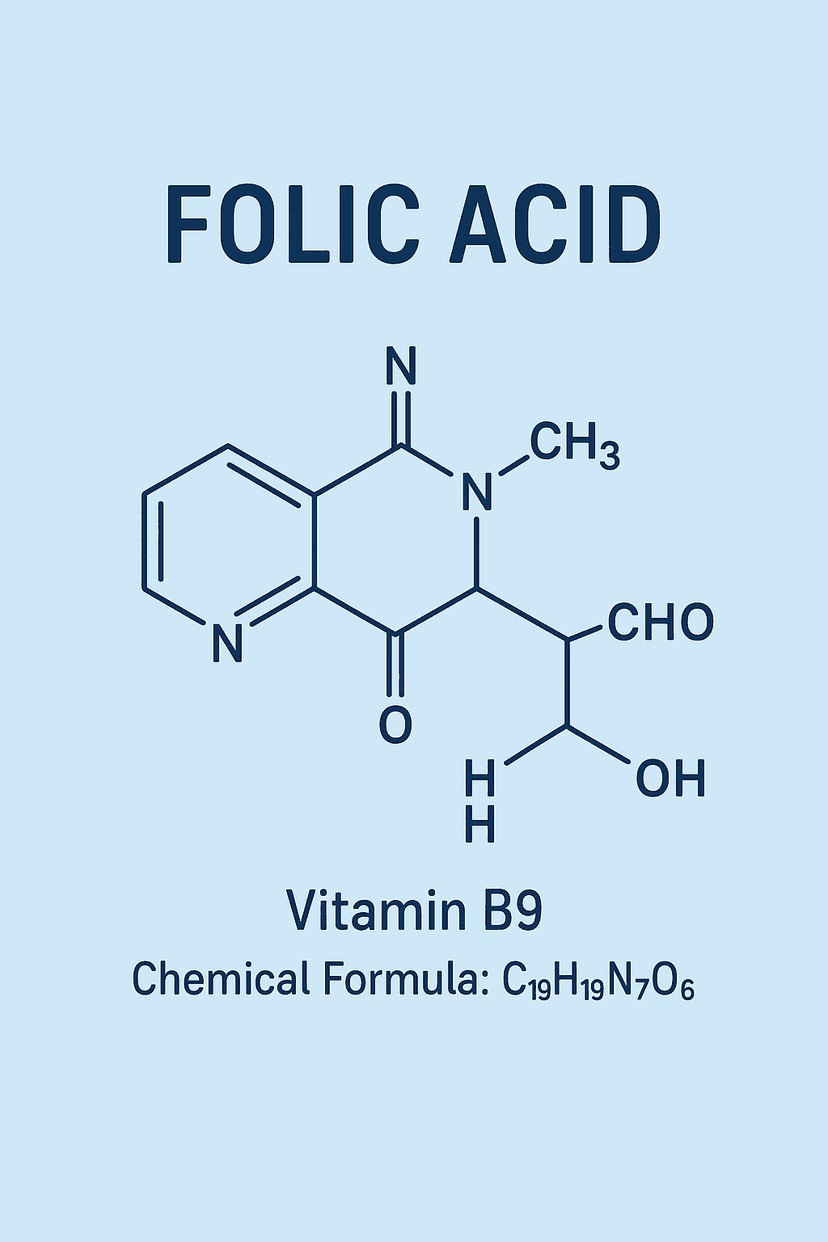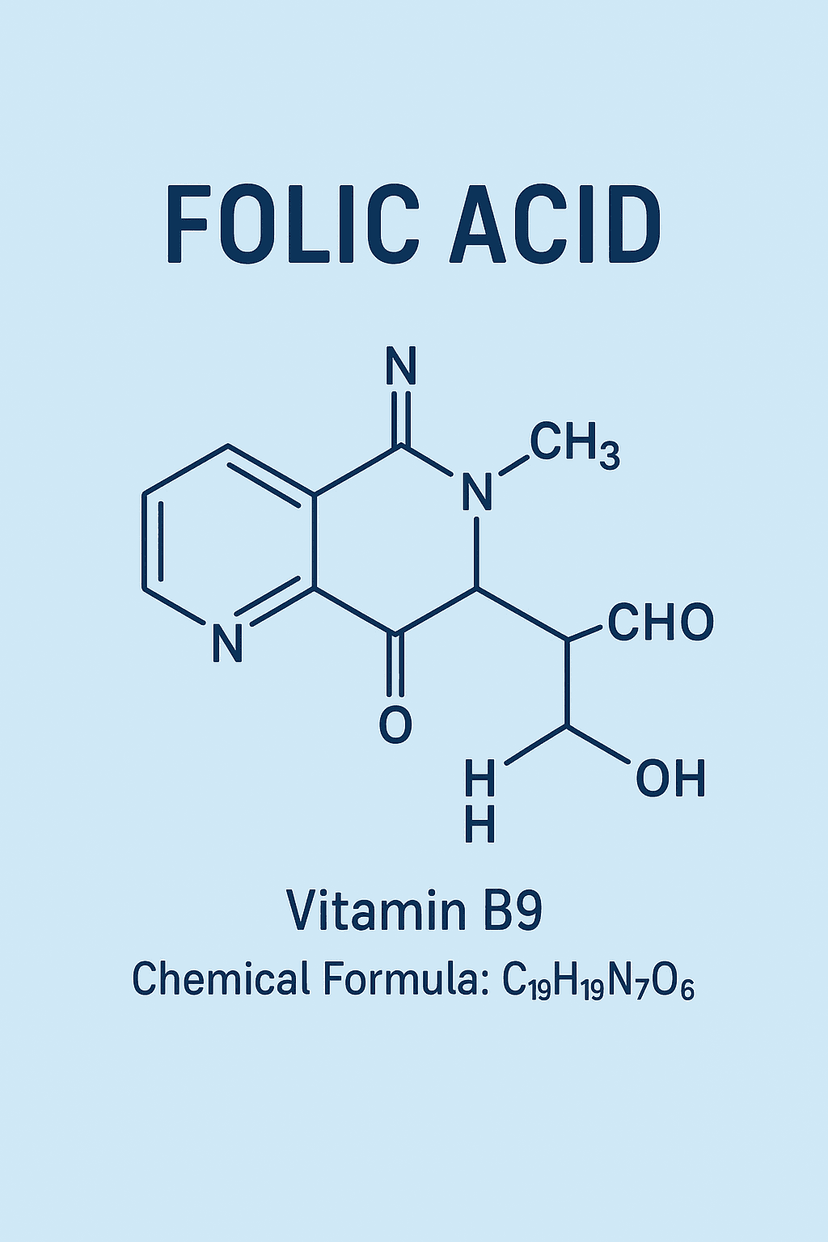
Folic Acid (Vitamin B9)

Common Name
Folic acid; Vitamin B9; pteroylmonoglutamic acid; folate (umbrella term).
Family
Water-soluble B-complex vitamin.
Parts Used
nutrient/supplement
Native To
Naturally occurring food folates are ubiquitous in leafy greens, legumes, and citrus.
Historical and Traditional Uses:
1930s–40s: Folate factor” identified; folic acid synthesized (1945). 1960s–80s: Used to treat megaloblastic anemia due to folate deficiency. 1990s–present: Periconceptional folic acid recognized to prevent neural tube defects (NTDs). Many countries instituted grain fortification.
Chemical Composition:
- Structure: Pteridine ring + p-aminobenzoic acid + glutamate (monoglutamate).
- Biologically active forms (in cells): Dihydrofolate (DHF) → tetrahydrofolate (THF) → 5,10-methylene-THF and 5-methyltetrahydrofolate (5-MTHF). These carry one-carbon units for DNA synthesis and methylation
Pharmacological Properties:
- Essential cofactor in one-carbon metabolism for de novo synthesis of purines and thymidylate and for remethylation of homocysteine to methionine; lowers circulating homocysteine.
- Pharmacokinetics: Synthetic folic acid (monoglutamate) is well absorbed; converted in liver to active folates
Evidence-Based Uses and Benefits:
1. Prevention of Neural Tube Defects (NTDs) Daily periconceptional folic acid reduces first-occurrence NTDs (spina bifida, anencephaly). Landmark RCT and population data support 400 µg/day before conception through early pregnancy. 2. Treatment of Folate-Deficiency Megaloblastic Anemia Corrects hematologic abnormalities caused by inadequate folate intake/absorption (after excluding B12 deficiency). 3. Adjunct with Low-Dose Methotrexate (Rheumatoid Arthritis) Folic or folinic acid reduces MTX-related adverse effects (GI, mucosal, liver enzyme elevations) without compromising efficacy. 4. Homocysteine Reduction Supplementation lowers plasma homocysteine (a risk marker). Cardiovascular outcome benefits remain uncertain and inconsistent. 5. Other areas under study (mixed/insufficient evidence): fertility parameters, mood (adjunctive L-methylfolate in some MDD patients), cognition in deficiency states.
Dosage Guidelines:
- General adults (RDA, as Dietary Folate Equivalents—DFE): 400 µg DFE/day (≈ 240 µg folic acid taken with food; 400 µg if taken empty stomach).
- Women who could become pregnant: 400 µg/day folic acid at least 1 month before conception and during early pregnancy.
- Pregnancy: 600 µg DFE/day; history of NTD-affected pregnancy: 4 mg/day folic acid starting ≥1 month pre-conception through first trimester (medical supervision).
- Tolerable Upper Intake Level (UL): 1,000 µg/day (1 mg) of synthetic folic acid for adults (from supplements/fortified foods; does not include food folate). Note: In RA on low-dose methotrexate, common regimens are 1 mg folic acid daily or 5 mg once weekly (several schedules exist; follow clinician guidance).
Counter-Indications:
Untreated Vitamin B12 deficiency: Folic acid can correct anemia while allowing neurologic damage from B12 deficiency to progress (“masking”); rule out B12 deficiency before high-dose folic acid. Cancer care using high-dose methotrexate/antifolates: Folic acid may interfere with cytotoxic intent oncology dosing uses folinic acid (leucovorin) rescue under specialist protocols; patients should not self-supplement
Side Effects:
Generally well tolerated at recommended intakes. Possible GI upset, nausea, bitter taste, sleep disturbances or excitability at high doses; rare allergic reactions. Chronic intakes above UL may increase risk of masking B12 deficiency and have uncertain links to some cancers in specific contexts.
Drug Interactions:
- Antifolate antibiotics (trimethoprim, sulfamethoxazole/trimethoprim; pyrimethamine): These inhibit microbial folate synthesis; high folic acid can antagonize antiparasitic action of pyrimethamine; conversely, antibiotics may lower folate status. Manage under medical supervision.
- Antiepileptics (phenytoin): Folic acid can reduce phenytoin concentrations and potentially lower seizure control; monitor levels and adjust dose.
- Low-dose methotrexate for RA: Co-prescribed folic/folinic acid reduces adverse effects without reducing MTX efficacy. Do not apply this to oncology MTX.
- Other antifolates (trimetrexate, pralatrexate), sulfasalazine: May impair folate status; specialist oversight required.
- Alcohol: Heavy use lowers folate status; increases deficiency risk.
Research and White Papers with Links:
- Folate (Folic Acid) Fact Sheet. Comprehensive on metabolism, RDAs, UL, safety: https://ods.od.nih.gov/factsheets/Folate-HealthProfessional/
- Dosage for people who could become pregnant: https://pmc.ncbi.nlm.nih.gov/articles/PMC4738404/
- RCT showing periconceptional multivitamins containing folic acid reduce first-occurrence NTDs: https://pubmed.ncbi.nlm.nih.gov/19161162/
- Recommendation Statement. Recommends 0.4–0.8 mg folic acid daily for all who plan or could become pregnant: https://pubmed.ncbi.nlm.nih.gov/37526713/
- Folic/folinic acid reduces side effects in methotrexate-treated RA without loss of efficacy: https://pmc.ncbi.nlm.nih.gov/articles/PMC7046011/
- Supports protective effect of folate supplementation with methotrexate in RA: https://pubmed.ncbi.nlm.nih.gov/29975207/
- Folic acid alters phenytoin kinetics; monitor https://pubmed.ncbi.nlm.nih.gov/7860949/
- UL 1 mg/day synthetic folic acid for adults: https://www.ncbi.nlm.nih.gov/books/NBK554487/
- Masking B12 deficiency. Clinical caution with high-dose folic acid: https://pmc.ncbi.nlm.nih.gov/articles/PMC11288374/
Conclusions:
Folic acid is a well-characterized, highly effective public -health intervention for preventing neural tube defects and for treating folate-deficiency anemia. It’s generally safe at recommended intakes, but high doses can mask B12 deficiency and interact with certain drugs (notably phenytoin, antifolate antimicrobials, and methotrexate regimens). Use targeted dosing for pregnancy planning and under clinician guidance when combined with interacting medications.
